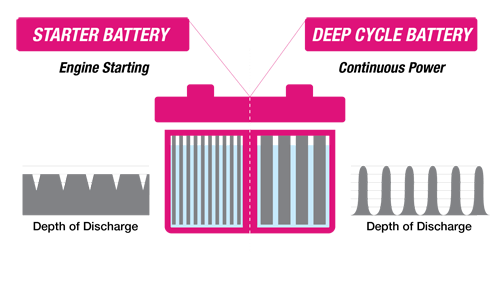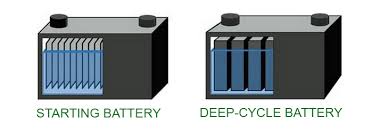Difference between a deep cycle and a regular battery?
Choosing the right battery for your needs can be daunting, especially with the plethora of options available. Among the most commonly debated are deep cycle batteries and regular batteries. To make an informed decision, it’s crucial to understand their differences, applications, and benefits.
In this article, we will talk about deep cycle batteries and regular batteries. We will help you decide which one is best for your energy needs.

Understanding Battery Basics
Before diving into the differences, let’s first understand the basics of batteries. Batteries store electrical energy and release it as needed to power various devices. They consist of one or more cells, each containing a positive electrode (cathode), a negative electrode (anode), and an electrolyte.
What is a Deep Cycle Battery?
A deep cycle battery is designed to provide a steady amount of current over a long period. Regular batteries give a short burst of energy. Deep cycle batteries can be charged and discharged many times without getting damaged.
Key Features of Deep Cycle Batteries
- Durability: Deep cycle batteries are constructed to withstand multiple discharge and recharge cycles, making them highly durable.
- Energy Efficiency: These batteries are designed to be energy-efficient, providing consistent power over an extended period.
- Discharge Capacity: Deep cycle batteries can be discharged to a much lower percentage of their capacity without causing damage, usually up to 80% depth of discharge (DoD).
Common Applications
- Marine and RV Use: Deep cycle batteries are commonly used in boats and recreational vehicles due to their ability to provide reliable power over long periods.
- Solar Power Systems: They are ideal for solar power systems, where consistent and reliable energy storage is crucial.
- Electric Vehicles: Many electric vehicles use deep cycle batteries due to their high energy efficiency and longevity.
What is a Regular Battery?
Regular batteries, often referred to as starting, lighting, and ignition (SLI) batteries, are designed to provide a quick burst of energy. This makes them ideal for applications where a high amount of current is required for a short period, such as starting a car engine.
Key Features of Regular Batteries
- High Current Delivery: Regular batteries are designed to deliver a high amount of current in a short burst.
- Shorter Lifespan: These batteries are not intended for deep discharge and have a shorter lifespan compared to deep cycle batteries.
- Quick Recharge: Regular batteries can be recharged quickly, making them suitable for applications where frequent energy bursts are needed.
Common Applications
- Automotive Use: Regular batteries are primarily used in vehicles to power the ignition system and other electronic components.
- Backup Power: They are often used in uninterruptible power supplies (UPS) for short-term backup power.
- Portable Electronics: Many portable electronic devices use regular batteries due to their ability to provide quick bursts of power.
Deep Cycle vs Regular Battery: Key Differences
Knowing the main differences between deep cycle and regular batteries can help you pick the right one for you.

Design and Construction
- Deep Cycle Batteries: Built with thicker plates and denser active material to withstand repeated discharging and recharging cycles.
- Regular Batteries: Constructed with thinner plates designed to provide quick bursts of energy, making them less durable for deep discharges.
Performance and Efficiency
- Deep Cycle Batteries: Offer consistent performance and high energy efficiency over extended periods.
- Regular Batteries: Provide high performance for short bursts but are less efficient over prolonged use.
Lifespan and Durability
- Deep Cycle Batteries: Have a longer lifespan due to their ability to handle deep discharges without significant damage.
- Regular Batteries: Generally have a shorter lifespan as they are not designed for deep discharge cycles.
Cost and Maintenance
- Deep Cycle Batteries: Typically more expensive upfront but offer long-term savings due to their durability and efficiency.
- Regular Batteries: Less expensive initially but may incur higher costs over time due to more frequent replacements.
Choosing the Right Battery for Your Needs
When deciding between a deep cycle battery and a regular battery, consider the following factors:
Application
Identify the primary use of the battery. If you need a battery to start a car or give quick bursts of power, a regular battery should work fine.
For applications requiring consistent power over extended periods, such as marine, RV, or solar power systems, a deep cycle battery is the better choice.
Budget
Consider your budget and the long-term costs associated with each type of battery. Deep cycle batteries cost more upfront but last longer and are more efficient, which can save money in the long run.
Maintenance
Evaluate the maintenance requirements of each battery type. Deep cycle batteries often require more maintenance to ensure optimal performance, while regular batteries are generally low-maintenance.
Environmental Impact
Consider the environmental impact of your battery choice. Deep cycle batteries last longer and are better for the environment because they don’t need to be replaced as often.
Conclusion
To make a good choice that fits your energy needs and budget, it’s important to know the difference between deep cycle and regular batteries. Deep cycle batteries offer durability, efficiency, and longevity, making them ideal for applications requiring consistent power over long periods.
Regular batteries give a lot of power quickly for a short time. They work well in cars and for backup power.
By evaluating your specific needs and considering factors such as application, budget, maintenance, and environmental impact, you can choose the right battery to power your devices efficiently and effectively.